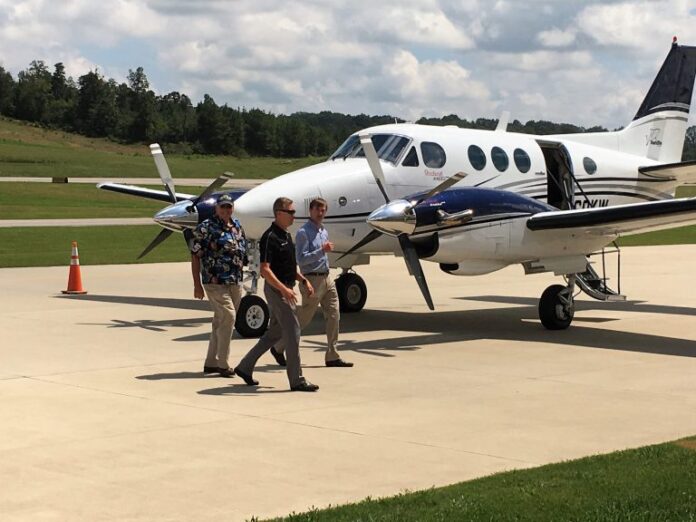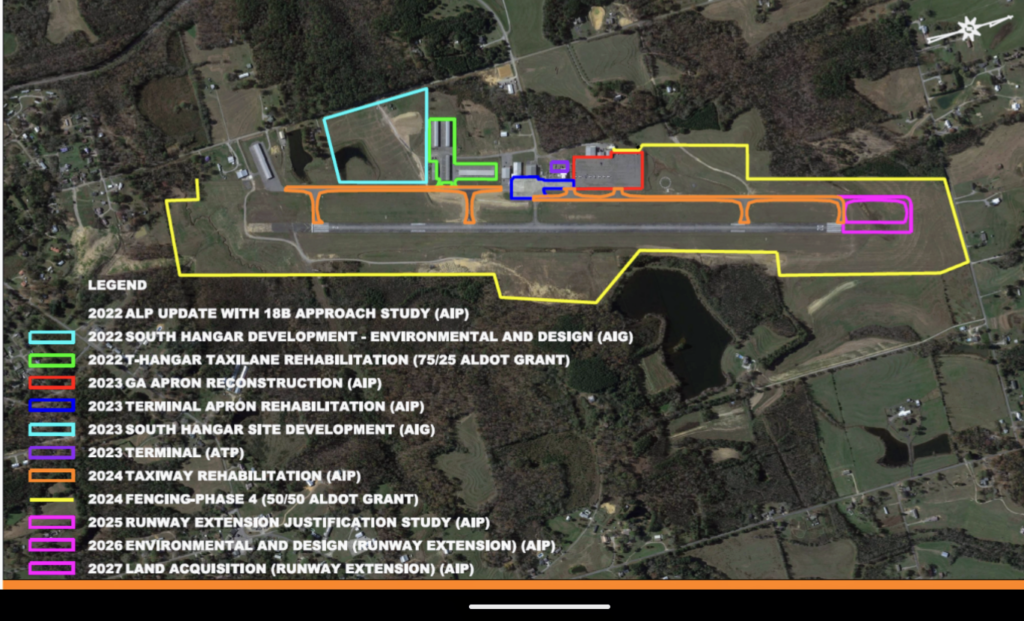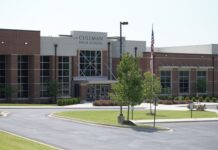
VINEMONT, Ala. – With both the State of Alabama and federal government investing millions of dollars in the Cullman Regional Airport by way of the Bipartisan Infrastructure Law (BIL), specifically the Airport Infrastructure Grant (AIG), plans are in the works to update the Vinemont airport and make it a contender for high-dollar contracts. Those contracts could bring an increased quality of life for the community, tax revenue for both the city and county and better paying job options.
“The Bipartisan Infrastructure Law is a once-in-a-generation investment in America’s transportation network. It will modernize infrastructure, increase equity in transportation, help fight climate change, strengthen the supply chain and create jobs,” according to the Federal Aviation Administration. The $25 billion federal grant will be divvied up with $15 billion going to airport infrastructure and $5 billion each allocated to air traffic facilities and airport terminals.
For Alabama specifically, the law affords about $142 million for airport infrastructure development over a five-year period. Airport needs including runway improvements, terminal development and revamped taxiways and towers are eligible for grant money disbursement.
With a population boom of 23.9% in the city of Cullman since our previous census and county’s 9% population increase in the same time frame, Cullman was one of only a handful of counties in Alabama to see an increase in residents. As the fourth fastest growing county in the state, Cullman’s unemployment is at a mere 1.9% compared to Alabama’s 2.6% and the nation’s 3.6%.
According to Cullman Economic Development Agency Director Dale Greer, “Our goal is to now provide better paying jobs for Cullman residents. The airport is a key factor in supplying those jobs. If everyone is working and making $40,000, then you bring in better jobs so that everyone is making $70,000, $80,000, $90,000 or $100,000 a year. With these potential contracts that we’re missing out on, we could do that.”
Greer explained, “This airport has not capitalized on the potential that exists in Huntsville, particularly military contracts. We’ve had an opportunity to land several maintenance repair facilities, but we don’t have the building that is required. They come in and love our community and tour our town. They recognize and appreciate our location in regard to Birmingham and Huntsville. Then they say, ‘Hang on. What hangar space have you got?’ When we tell them none, they say that for us to have a defense contract you’ve got to have a physical address to bid on all of those. As a result, we don’t get those contracts. We’re not even in the race to contend because we don’t qualify.”
The potential $10 million-plus project at the Cullman Regional Airport would require less than a 3% investment, or $60,000 over five years, from both the City of Cullman and Cullman County Commission for a total of $300,000 each.
“The significance is that both the state and the federal government believe that this is worth putting a lot of money into. They’re committed to helping us grow and committed to doing things to help us get it all done,” said Greer.
Cullman Regional Airport General Manager Ben Harrison spoke about the difference between commercial and general aviation and how improving Cullman’s general aviation airport can lead to more revenue.
“Commercial jets move people. General aviation, which is what we are, moves businesses. We’re able to do things that commercial service can’t do,” Harrison said. “Commercial service is scheduled. Every day that aircraft takes off at the same time. They have their scheduled slot times. People don’t take a corporate jet into a hub like Atlanta because those slots are filled by commercial airlines like Delta or American Airlines. So, the business jets go to an outlier airport like, potentially, us.”
He continued, “If we do not have a strong, viable airport that can accommodate corporate jets, business jets and cargo, we will not be able to grow our community.”
The impression of some residents is that the airport caters to the affluent, but Harrison disputes that misconception.
“Those are the people who determine jobs. They might be rich, but they employ hundreds or thousands of people,” he said. “They want to bring jobs here, but they can’t get their planes in at our airport. Private planes are their mode of transportation because it’s faster and more efficient. They don’t want to fly into Birmingham, Atlanta or Huntsville and drive here. That’s a waste of time for corporate executives.
“In 2014, we made a plan for fundamental changes for the future of our airport, and those projects are complete. Now, it’s time to implement the next plan.”
The 2014 plan’s roadmap was the Airport Layout Plan (ALP), a meticulous map with a legend accounting for every square inch of the property.

Harrison explained the intricacies of the ALP, saying, “Everything has to be in place. This will tell us exactly what the runway data is, such as, ‘Did the magnetic variation change?’ ‘Is our compass alignment still correct with the earth’s changes and shifts?’ ‘Are our object-free areas still correct?’ ‘What about our runway safety areas?’ All of that has to be surveyed out: medium-intensity lots, high-intensity lots, non-precision, precision, etc. This will tell us what we can and cannot do. All that is surveyed. Every bit of that must be in place. The ALP is a seven-year guideline on what we can do. We did this in 2014.”
The forward-thinking Harrison keeps his eyes on the future and keeping the airport’s progress in on track. By doing so, the long-term costs are kept to a minimum, much like maintaining one’s vehicles with routine maintenance like oil and filter changes.
“My goal is, as long as I’m here, is I don’t want to touch the same project twice. That’s accomplished by doing a project, building it and maintaining it properly. Without the maintenance plan, the infrastructure falls apart. If the infrastructure falls apart, no one comes here to land their planes,” Harrison said. “All the taxiways will be rehabbed in less than 10 years of new. We had to completely rebuild them at the tune of about $3.8 million. For a $300,000 investment, we’re going to preserve them. That preservation will take a 20-year pavement maintenance and kick it up to a 30-year maintenance, and, if we keep at it, we can get maybe 40 years out of it.”
With Harrison’s long-range vision coupled with Greer’s experience and expertise, Cullman Regional Airport has the potential to become a pin in the hat of both the City of Cullman and Cullman County as a whole, as long as the community’s leaders agree to it.
Copyright 2022 Humble Roots, LLC. All Rights Reserved.

























